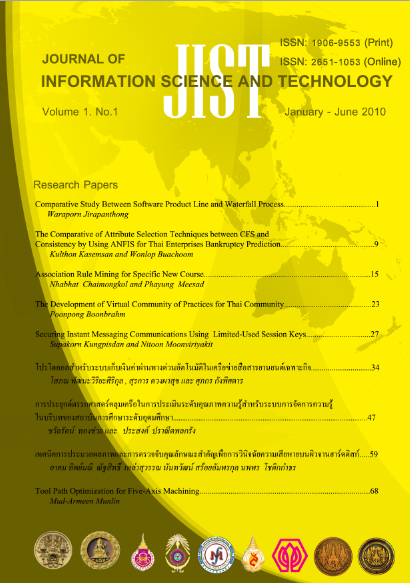Association Rule Mining for Specific New Course
Main Article Content
Abstract
- Most language schools devote a significant portion of their budget on new courses to distinguish their school from their competitors and to increase the number of students. The schools should specify courses that fulfill the students‟ needs. This will raise the competitiveness of the schools. Also the schools will earn higher loyalties and profits because of the increase of new students. This article proposes a Mining Course Map (MCM) algorithm for investigating on the relationships among students‟ demands, type of course and transaction records. MCM is a modified association rule analysis based-on FP-growth algorithm. For comparison study, the proposed method was compared with Association Rule Miner And Deduction Analysis (ARMADA). The results show that the execution time of MCM is less than ARMADA which means that MCM is more efficient than the ARMADA. In addition, the results show that different knowledge and rules can be extracted from students to specify new courses for new and old members. This paper suggests that the school should extract knowledge from student demands. The knowledge can be used to manage new courses properly.
Article Details
This work is licensed under a Creative Commons Attribution-NonCommercial-NoDerivatives 4.0 International License.
I/we certify that I/we have participated sufficiently in the intellectual content, conception and design of this work or the analysis and interpretation of the data (when applicable), as well as the writing of the manuscript, to take public responsibility for it and have agreed to have my/our name listed as a contributor. I/we believe the manuscript represents valid work. Neither this manuscript nor one with substantially similar content under my/our authorship has been published or is being considered for publication elsewhere, except as described in the covering letter. I/we certify that all the data collected during the study is presented in this manuscript and no data from the study has been or will be published separately. I/we attest that, if requested by the editors, I/we will provide the data/information or will cooperate fully in obtaining and providing the data/information on which the manuscript is based, for examination by the editors or their assignees. Financial interests, direct or indirect, that exist or may be perceived to exist for individual contributors in connection with the content of this paper have been disclosed in the cover letter. Sources of outside support of the project are named in the cover letter.
I/We hereby transfer(s), assign(s), or otherwise convey(s) all copyright ownership, including any and all rights incidental thereto, exclusively to the Journal, in the event that such work is published by the Journal. The Journal shall own the work, including 1) copyright; 2) the right to grant permission to republish the article in whole or in part, with or without fee; 3) the right to produce preprints or reprints and translate into languages other than English for sale or free distribution; and 4) the right to republish the work in a collection of articles in any other mechanical or electronic format.
We give the rights to the corresponding author to make necessary changes as per the request of the journal, do the rest of the correspondence on our behalf and he/she will act as the guarantor for the manuscript on our behalf.
All persons who have made substantial contributions to the work reported in the manuscript, but who are not contributors, are named in the Acknowledgment and have given me/us their written permission to be named. If I/we do not include an Acknowledgment that means I/we have not received substantial contributions from non-contributors and no contributor has been omitted.
References
2. Hui, S. C. and Jha, G., “Data mining for customer service support,” Information & Management, Vol. 38, Issue 1, 2000. pp. 1-13.
3. Mehta, K. and Bhattacharyya, S., “Adquacy of training data for evolutionary mining of trading rules,” Decision Support Systems, Vol. 37, Issue 4 2004. pp 461-474.
4. Holmlund, M. and Strandvik, T., “Perception configurations in business relationships,” Management Decision, Vol. 37, Issue 9, 1999. pp. 686-696.
5. Liao, S. H., Hsieh, C. L. and Huang S. P., “Mining product maps for new product development,” Expert Systems with Applications, Vol. 34, Issue 1, 2008. pp. 20-62.
6. Manlone, J., Association Rule Miner And Deduction Analysis (ARMADA), User Manaual, 2003. pp. 1-20.
7. Said, A. M., Dominic, P.D.D. and Abdullah, A. B., “A Comparative Study of FP-growth Variations”, International Journal of Computer Science and Network Security, VOL.9 No.5, May 2009, pp. 266-272.
8. Jeffrey W. Seifert, Data mining: And overview, Congressional Research Service, Order Code RL31798, 2004.
9. Trewartha, D., Investigating Data Mining in MATLAB, Bachelor (Honours) of Science Thesis of Rhodes University, 2006.
10. Li, H., Wang, Y., Zhang, D., Zhang, M. and Chang, E., “PFP: Parallel FP-Growth for Query Recommendation”, ACM Recommendation Systems, October 2008.
11. Frawely, W. J., Shapiro, P. G., and Matheus, C. J. “Knowledge discovery in databases: An overview”, AAAI/MIT Press, 1991, pp. 1-27.
12. Erwin, A., Gopalan, R. P., and Achuthan, N. R. “CTU-Mine: An Efficient High Utility Itemset Mining Algorithm Using the Pattern Growth Approach”, IEEE 7th International Conferences on Computer and Information Technology, 2007, pp. 71-76.
13. Cunningham, S. J. and Holmes, G. “Developing innovative applications in agriculture using data mining,” the Proceedings of the Southeast Asia Regional Computer Confederation Conference, Singapore, 1999.
14. Wojciechowski, M., Galecki, K., and Gawronek, K. “Concurrent Processing of Frequent Itemset Queries Using FP-Growth Algorithm”, Proc. of the 1st ADBIS Workshop on Data Mining and Knowledge Discovery



